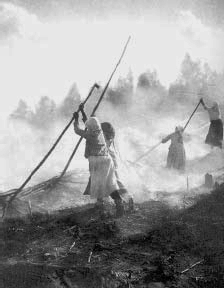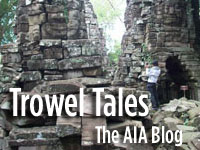An Inconvenient Truth in 5000 B.C.
by Heather Pringle
August 21, 2009
 When did human beings first begin leaving their heavy, mucky, ruinous footprints on the environment? When did our ancestors start overhunting great herds of bison and other large game, fishing ocean stocks to exhaustion and boosting global levels of greenhouse gases in the atmosphere?  Most environmentalists tend to pin the blame entirely on recent generations —laying the responsibility at the feet of those who lived from the industrial revolution to the present day.
When did human beings first begin leaving their heavy, mucky, ruinous footprints on the environment? When did our ancestors start overhunting great herds of bison and other large game, fishing ocean stocks to exhaustion and boosting global levels of greenhouse gases in the atmosphere?  Most environmentalists tend to pin the blame entirely on recent generations —laying the responsibility at the feet of those who lived from the industrial revolution to the present day.
But popular as this view is, it is short-sighted and plainly wrong-headed.  I first began to twig to this fact in the 1990s when I was researching a book chapter on Head-Smashed-In Buffalo Jump in Southern Alberta. As I strolled the windblown site with Royal Museum of Alberta archaeologist Jack Brink—who excavated the jump’s massive bone bed over a nine-year period— he took me completely by surprise.  The first people to drive herds over the jump, some 5700 years ago, he explained, slaughtered far more animals than they needed. “These people weren’t concerned with storage of food or with getting all the nutritional value out of a carcass that they possibly could,†Brink said.   “It was more like, ‘Let’s get a big meat meal. Let’s stuff ourselves and get out of here.â€
Indeed, nearly 4000 years passed at Head-Smashed-In before hunters began diligently reversing this trend.  Around 2000 years ago, they began boiling bison bones from their kills to extract grease:  this they mixed with bison meat and berries to make pemmican, which they then stored in sewn rawhide bags. It was a clever way of preserving meat: some historical accounts suggest that pemmican could be successfully stored in these airtight bags for 20 years. In other words, later bison hunters of Southern Alberta were far less wasteful and profligate than their predecessors: they extracted all the calories possible from their kills.
Now a new article in Quaternary Science Reviews serves up yet another fascinating example of how early, preindustrial peoples impacted their environment—this time by looking at greenhouse gases.  Two climate scientists, William Ruddiman at the University of Virginia in Charlottesville and Erle Ellis at the University of Maryland in Baltimore County, did this by examining both archaeological data on forest clearance by early agriculturalists and environmental data on carbon dioxide levels in the atmosphere over time.
Early farmers, who practiced slash-and-burn agriculture, cleared vast tracts of land in order to support a family. One square kilometer fed less than 15 people. But as populations rose over time, cultures greatly improved on this.  They developed sophisticated canal and irrigation systems, fertilized crops with manure from livestock,  controlled insects,  and planted two or more crops a year. With  intensive agricultural practices,  one square kilometer could feed more than 250 people.
What this all means is that early farmers were clearing forests like crazy—indeed to a far greater extent than climate scientists had previously recognized. Intrigued by this, Ruddiman and Ellis began looking at the trajectory of greenhouse gases in the atmosphere beginning some 7000 years ago. Their new findings strongly suggest that farmers were releasing major amounts of carbon into the atmosphere as early as 7000 years ago by cutting down vast tracts of trees. And all this added significantly to our planet’s levels of greenhouse gases.
I think this is an important study for several reasons. It shows us, says Ruddiman, that early farmers “had surprisingly large effects [on the environment] despite their low numbers.â€Â  And it also clearly reveals the great relevance of data from the ancient past to understanding one of the most pressing matters on the political agenda today – climate change.  For archaeologists, whose work is regarded by some as musty and irrelevant, this is a very welcome development.
Comments posted here do not represent the views or policies of the Archaeological Institute of America.






 Heather Pringle is a freelance science journalist who has been writing about archaeology for more than 20 years. She is the author of Master Plan: Himmler's Scholars and the Holocaust and The Mummy Congress: Science, Obsession, and the Everlasting Dead. For more about Heather, see our
Heather Pringle is a freelance science journalist who has been writing about archaeology for more than 20 years. She is the author of Master Plan: Himmler's Scholars and the Holocaust and The Mummy Congress: Science, Obsession, and the Everlasting Dead. For more about Heather, see our 



